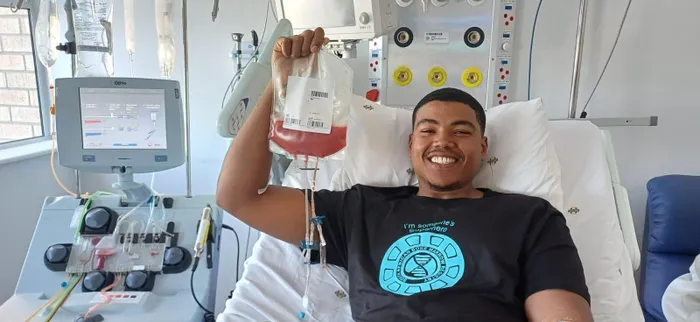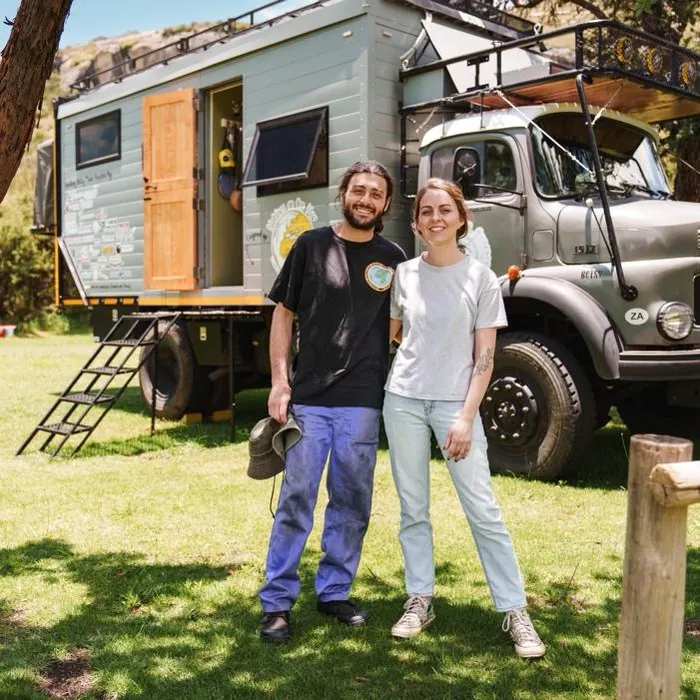Local apprentice mechanic becomes lifesaving stem cell donor for patient in South America

ONE IN 100 000 MATCH: Bradley Peters (23), an apprentice mechanic from East London, has been identified as a stem cell donor match for a patient in South America. Peters signed up by chance during an awareness drive for the Matches on the Map campaign last year, making him the first confirmed match for a patient, not only in the country, but across the 64-country, 10-year voyage. The campaign is spearheaded by former transplant survivor, Robin Lewis and his wife Jolandie.
Image: Supplied
A YOUNG apprentice mechanic from East London who signed up as a stem cell donor by chance has become a 1 in 100 000 lifesaving match for a patient in South America.
Twenty-three-year-old Bradley Peters is now the first confirmed match for a patient, not only in the country but across the 64-country, 10-year Matches on the Map campaign.
The Matches on the Map inter-continental stem cell recruitment drive is spearheaded by former transplant survivor, Robin Lewis and his wife Jolandie who left Mpumalanga on their epic journey in September 2023.
To date the campaign has garnered more than 1 000 eligible stem cell donor sign-ups to the South African Bone Marrow Registry (SABMR). Peters signed up with the Matches on the Map team at an awareness drive last year. Nearly six months to the day, he received a call from the SABMR informing him that he was a potential match for a patient in far-flung South America. Peters, who went on to donate his stem cells, said he never thought that such a small act would result in potentially saving the life of another person 6500 km across the South Atlantic Ocean.
“When they called me… I had already forgotten that I had signed up to the SABMR. I had no idea that a cheek swab would be the beginning of saving someone’s life. After I received the call, the SABMR set the wheels in motion to conduct the necessary testing to confirm whether I was a suitable match,” said Peters.

Robin Lewis and his wife, Jolandie, pictured here with their custom-built truck, Betsy. The pair started on their intercontinental journey in September 2023, to find stem cell matches during their travels. Lewis was diagnosed with Fanconi Anaemia, a genetic DNA repair disorder that can lead to bone marrow failure, leukaemia and or solid tumours in the body. He successfully underwent a stem cell transplant in 2018, which completely changed his outlook on life.
Image: Supplied
The chance of finding a suitable stem cell donor match for any patient is 1 in 100 000 and the odds increase even further based on ethnicity. The donor pool in South Africa is unfortunately not reflective of the country’s population, meaning that the chance of finding a donor for patients of colour is near impossible.
Deputy director for the SABMR, Jane Ward, said additional stem cell donor sign-ups to the registry means that more lives can be saved not only in South Africa, but abroad as well.
“Only 30% of people are lucky enough to find donors in their family, while the remaining 70% must look elsewhere for a match.“Despite access to nearly 43 million registered donors globally through the World Marrow Donor Association, many patients in desperate need still do not find a suitable donor with a matching tissue type. The more donors we have, the more patients we can help. We are honoured to have been able to secure a match within South Africa to give this patient a second chance at life,” Ward explained.
Peters said while his family was initially sceptical about him donating his stem cells due to not understanding the procedure, they were fully behind him. He said if he could do it again, he would do so in a heartbeat.
“Once I explained to them that it was not invasive and that it would not harm me in any way, but rather save someone’s life, I had their full support. I still can’t believe that I was part of something this special, I have always wanted to give back in some way, I never thought that this would be my fate. Every day is another chance to be a better person and if I could do it, so could anyone else.”
The Matches on the Map team is currently in Namibia, after which they will be off to Angola, where the SABMR will be assisting with a translator and an additional team member to help recruit stem cell donors. Lewis said finding a match en-route is a dream come true. Lewis was diagnosed with Fanconi Anaemia, a genetic DNA repair disorder that can lead to bone marrow failure, leukaemia and or solid tumours in the body. He underwent a stem cell transplant in 2018.
“Finding our first match in Bradley has hugely motivated us to keep pushing onwards. We’ve been on the road for the last 19 months and held successful recruitment drives in Eswatini, Lesotho and South Africa, and we’re currently traversing our fourth country, Namibia. This has by far been the highlight of our project.”
Lewis said if it wasn’t for a breakdown of their custom-built motor home, “Betsy”, they would never have met Peters in East London or known that he would have been a suitable donor match.
“While Betsy was being repaired, we found ourselves living in the workshop for more than two weeks, working alongside technicians to fix her up. Since the start, we were confident that the entire 10-year project, including the four years it took to build the truck, would all be worth it, if we found one match. We were extremely grateful and humbled when this happened within our first year and in our home country.”
Lewis called on corporates, companies, schools and individuals to support the campaign.
“There are many ways to get involved with this project. The first is by attending one of our stem cell recruitment drives and signing up as a donor. We’re also looking to connect with local communities along our route to help us set up these drives and host awareness talks, giving more people the opportunity to register.”
If you are between the ages of 16 and 45 and relatively healthy, you may be eligible to become a stem cell donor. To register and view the donor exclusion criteria, visit www.sabmr.co.za
Cape Times